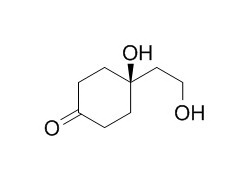Cleroindicin B
Cleroindicin B shows weak scavenging action on 2,2-diphenyl-l-picrylhydrazyl and hydroxyl radicals.
Inquire / Order:
manager@chemfaces.com
Technical Inquiries:
service@chemfaces.com
Tel:
+86-27-84237783
Fax:
+86-27-84254680
Address:
1 Building, No. 83, CheCheng Rd., Wuhan Economic and Technological Development Zone, Wuhan, Hubei 430056, PRC
Providing storage is as stated on the product vial and the vial is kept tightly sealed, the product can be stored for up to
24 months(2-8C).
Wherever possible, you should prepare and use solutions on the same day. However, if you need to make up stock solutions in advance, we recommend that you store the solution as aliquots in tightly sealed vials at -20C. Generally, these will be useable for up to two weeks. Before use, and prior to opening the vial we recommend that you allow your product to equilibrate to room temperature for at least 1 hour.
Need more advice on solubility, usage and handling? Please email to: service@chemfaces.com
The packaging of the product may have turned upside down during transportation, resulting in the natural compounds adhering to the neck or cap of the vial. take the vial out of its packaging and gently shake to let the compounds fall to the bottom of the vial. for liquid products, centrifuge at 200-500 RPM to gather the liquid at the bottom of the vial. try to avoid loss or contamination during handling.
Aquaculture2019, 510:392-399
Iranian J. Pharm. Res.2021, 20(4):59-70
Hong Kong Baptist University2023, 048330T.
Phytomedicine.2024, 128:155527.
Proc Biol Sci.2024, 291(2015):20232578.
Agriculture2022, 12(12), 2173.
Korean Journal of Pharmacognosy2018, 49(3):270-277
Food and Bioprocess Technology2017, 10(6):1074-1092
Chem Res Toxicol.2023, 36(2):213-229.
Manomaniam Sundaranar University2023, 3859769.
Related and Featured Products
Nat.Prod.Commun.,2015, 10(8): 1387-90.
Biological Activity of Dolichandrone serrulata Flowers and Their Active Components.[Reference:
WebLink]
Dolichandrone serrulata (DC.) Seem flowers are widely used as vegetables in northern and eastern Thailand. Biological studies of the methanolic extract of these flowers have shown promising antioxidant activity.
METHODS AND RESULTS:
Biological-guided separation of D. serrulata flowers yielded six compounds, identified as hallerone, protocatechuic acid, rengyolone, Cleroindicin B, ixoside, and isomaltose. This is the first report on hallerone, protocatechuic acid, rengyolone, Cleroindicin B, and isomaltose in D. serrulata.
CONCLUSIONS:
Protocatechuic acid was the most potent scavenger of 2,2-diphenyl-l-picrylhydrazyl and hydroxyl radicals with IC50 values of 25.6 +/- 0.6 and 29.6 +/- 0.4 microM, respectively. Hallerone and rengyolone showed moderate scavenging action on superoxide radicals and inhibited H202 induced reactive oxygen species production in HEK-293 cell. In addition, the other isolated compounds showed weak activity.



